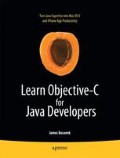Abstract
Organizing collections of objects is a fundamental part of everyday programming. The class frameworks provide several classes for organizing objects into arrays, dictionaries (maps), and sets. Objects in an array have a specific order, addressed by a numeric index. Dictionaries (maps) organize objects into unordered pairs, each pair being a unique key object and a value object. The key object is used to identify and address the value object. Finally, sets are amorphous collections that are neither ordered nor addressable; an object is simply in a set or it’s not. The Cocoa framework doesn’t provide any tree, linked list, or stack collections.
Access this chapter
Tax calculation will be finalised at checkout
Purchases are for personal use only
Preview
Unable to display preview. Download preview PDF.
Rights and permissions
Copyright information
© 2009 James Bucanek
About this chapter
Cite this chapter
(2009). Collection Patterns. In: Learn Objective-C for Java Developers. Apress. https://doi.org/10.1007/978-1-4302-2370-2_16
Download citation
DOI: https://doi.org/10.1007/978-1-4302-2370-2_16
Publisher Name: Apress
Print ISBN: 978-1-4302-2369-6
Online ISBN: 978-1-4302-2370-2
eBook Packages: Professional and Applied ComputingApress Access BooksProfessional and Applied Computing (R0)

